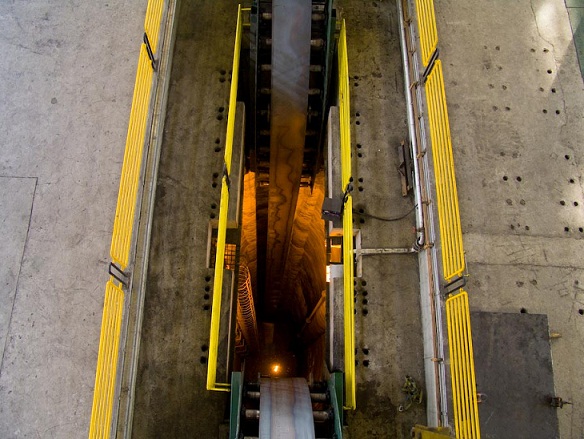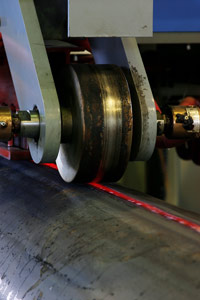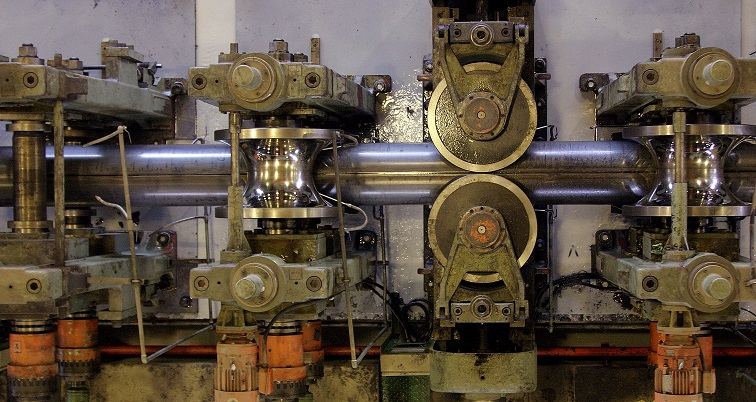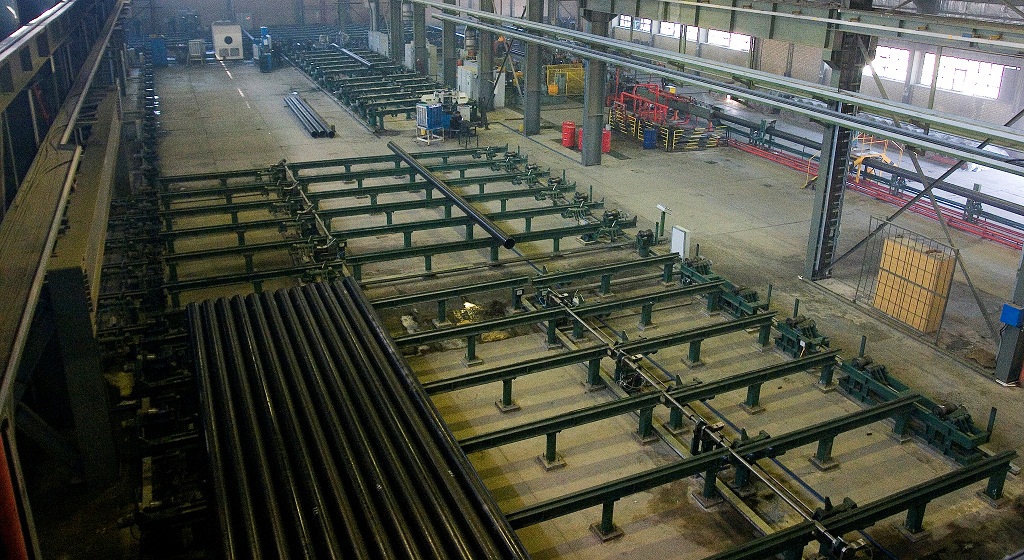
ERW Pipe Production Process:
Forming Section : This section includes the main machinery for producing pipes including coil processing, forming, resizing, and removing internal and external reinforcement, cutting and output line that are all provided by the Japanese company, KUSAKABE, which is one of the most popular companies in the field of designing and establishing pipe production manufactories internationally based on the latest technologies of the world.
Underground coil storage systems:
This type of coil storage system that was firstly developed and used by Kalup Co. is able to considerably increase the capacity of production line; compared to the usual storage devices called accumulator, this system does not need constant repair and enormous place for installation.

Rolling edge of sheet machine: This machine is able to roll the edge of sheets and prepare them for optimal welding conditions based on API 5L PSL 2 standards.
Welding machine:With the capacity of 500KW this machine is able to weld the prepared edge of sheets together in both CONTACT and INDUCTION modes.

Ultrasonic Thickness Measurement (UTM) Machine: This machine is installed after the external weld stenciling machine and it is able to measure welding thickness and determines if the thickness is standard or not.
ON-LINE Ultrasonic testing machine: This machine is able to detect the possible flaws in seam welding area and HAZ immediately after welding; thus it is able to immediately remove the defective pipe out of the production line.
Annealing machines: Two annealing machines with overall power of 800KW can meet the requirements of API 5L PSL 2 standards.
Eddy-Current testing machine: This device is able to detect the possible surface defects of seam welding after pipe cooling operation; thus it prevents defective pipes from entering the final operation area.
The final operation section:
Chamfering machine: This device chamfers the two ends of pipe based on the quality and tolerance determined in API %L PSL 2 standards.
Surfacing testing machine: This machine flattens the samples extracted from produced pipes based on API 5L PSL 2 standards.
Hydrostatic testing machine: This machine tests all produced pipes with maximum pressure of 5000PSI in hydrostatic mode.
OFF-LINE Ultrasonic testing machine: 8-channel ultrasonic testing machine is able to test seam welding of HAZ and also two ends of all produced pipes based on API 5L PSL 2 and to detect and mark out their possible defects.
Measuring section: Appropriate space and facilities are provided for measuring weight and length of each produced pipe based on the requirements of API 5L PSL 2 standards.

Pipe identification system:
In order to reach the aims of Kalup Co. for producing pipes with the highest quality, a computer system called PIS (pipe identification system) has been installed for increasing the ability to track pipe production and access to accurate history of production of each pipe in Kalup Co. In this system the information related to each pipe in each production station is registered and the summary and highlights are transferred to the server through an Ethernet network. This station could determine the history of production of each pipe to the descriptions of primary steel coil and its melting number. By the use of this system the customer is able to achieve a summary of production and testing stages of each pipe when required and thus the customer could be ensured about the accuracy of production and testing stages.

Dividing pipes based on compressive strength:
A) Weight method: This method is the oldest method. In this method each pipe with a determined nominal diameter has a standardized (STD) specific weight. Pipes that are one time strengthened are called XS and pipes that are two times strengthened are called XXS. This method has been approved by ASME and ASTM. Later this method is going to be fully explained in this website.
B) Programmed method:In this method the division of 1000 times working pressure of pipe on its allowable stress is used. The achieved number is round and called schedule number. This method has been approved by ANSI.
C) Coding method: In this method firstly the introduced standard and then the pipe grade are introduced based on the maximum stress of the yield point. In this regard pipes are specified with grades A, B, X42, X46, X52, X56, X60, X65, X70, U89, and U100. For example: a pipe with specifications of API-5LS-X60 produced in spiral form has a yield stress resistance of PSI60000.
Having 25 years of experience in production of ERW pipes, Kalup Co. is able to produce pipes with diameters ranging from 6 to 16 and thickness of 4 to 12.7 millimeters with the highest quality based on international standards.